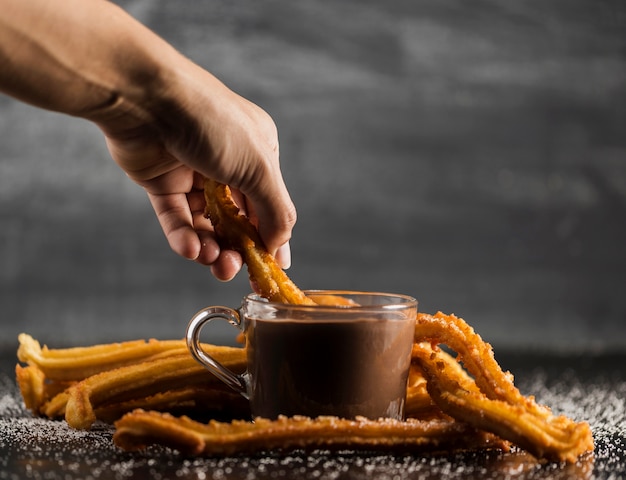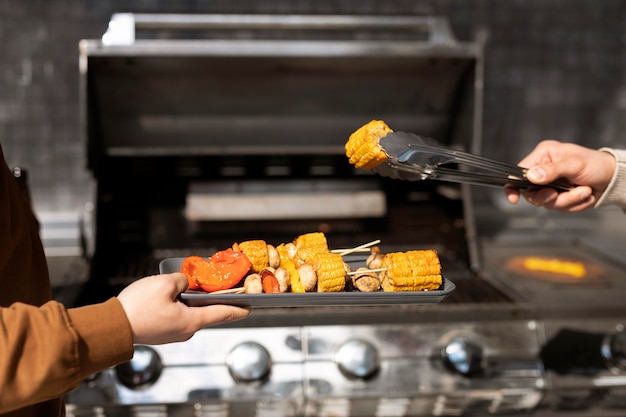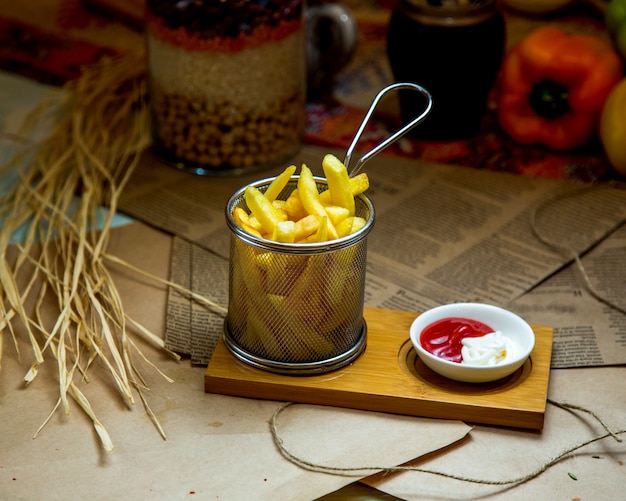There's a reason why fries are a global favourite. Those golden, crispy beauties, fluffy on the inside and perfectly seasoned, are a delicious treat that satisfies cravings and makes any meal a little bit better. But achieving that perfect fry at home can feel like a culinary quest. We've all been there, wrestling with soggy, limp chips or those overcooked disasters that resemble charcoal more than food.
But fear not, my fellow fry enthusiasts! After years of experimentation and countless batches of fries, I've finally cracked the code to achieving restaurant-quality chips in the comfort of my own kitchen. And I'm here to share my hard-earned wisdom with you.
This guide will delve into every aspect of crafting the perfect fry, from selecting the right potato to mastering the art of frying and understanding the science behind that perfect crunch. We'll explore the secrets to achieving ultimate crispiness, learn about the importance of resting time, and even discuss some creative seasoning and dipping sauce ideas to elevate your fries to new levels of deliciousness. So, grab your apron, gather your ingredients, and let's embark on this journey together.
(Part 1) The Foundation of Great Fries: choosing the right potato

You can't just grab any old potato and expect amazing fries. The type of potato you choose is crucial, and this is where many people go wrong. You wouldn't use the same potato for a roast as you would for mashed potatoes, would you? The same principle applies to fries.
The Importance of Starch Content: Unveiling the Science of Fry Perfection
The key to a perfect fry lies in the starch content of the potato. High-starch potatoes, like maris piper or king edward (both popular choices in the UK), are the ideal candidates. They possess a high moisture content, which contributes to the fluffy interior we all love, and a good amount of starch, which is essential for achieving that satisfyingly crispy exterior.
On the other hand, low-starch potatoes, like Desiree or Charlotte, are better suited for salads or boiling. Their waxy texture doesn't hold up well under the intense heat of frying, making them more likely to fall apart or turn into a mushy mess.
Spotting the Perfect Potato: A Guide for the Discerning Fry Enthusiast
When choosing potatoes for your fry adventure, keep these tips in mind:
- Avoid potatoes that are green or sprouting: This is a clear sign of solanine, a toxic substance that can make you ill. It's best to stick to potatoes with a smooth, unblemished skin.
- Look for potatoes that are firm and free from blemishes: A good potato should feel solid, not soft or squishy. This indicates good quality and freshness.
- Store your potatoes in a cool, dark, and dry place: This helps to prevent sprouting and ensures your potatoes stay fresh for longer.
If you're lucky enough to have a local greengrocer, I highly recommend heading there for your potatoes. They often have a wider selection than supermarkets, and you can even ask for advice on which varieties are best for frying.
(Part 2) Soaking Secrets: Unlocking the Ultimate Crisp

Now, you might be thinking, "Soaking? Really? What's the big deal?" Trust me, it's a game changer! Soaking your potato chips in cold water before frying is like giving them a spa treatment, prepping them for their grand entrance into the hot oil.
The Science Behind Soaking: Why It's Not Just a Silly Step
Here's why soaking is crucial:
- Removes Excess Starch: This step is vital! Excess starch can make your chips stick together during frying and hinder that coveted crispness.
- Draws Out Excess Moisture: This step ensures a crispier exterior and a fluffier interior, contributing to the perfect fry experience.
- Prevents Discolouration: Soaking helps to prevent the potatoes from turning brown or grey while they wait patiently for their turn in the hot oil.
Finding the Perfect Soak Time: A Balancing Act
The duration of your soak is crucial. Too short a soak, and you won't see much benefit. Too long a soak, and your potatoes will become waterlogged, leading to soggy and limp fries.
My golden rule is to soak them for at least 30 minutes, but ideally, 1-2 hours. For those thick-cut chips, don't hesitate to soak them overnight in the fridge. Just remember to drain them thoroughly before proceeding.
(Part 3) The Art of Cutting: Achieving Consistency and Shape

You've got your perfect potatoes, they've enjoyed their spa treatment, now it's time to get cutting. And, believe me, the way you cut your chips can have a significant impact on their final outcome.
Choosing Your Chip Shape: Experimentation is Key
For traditional fries, aim for a rectangular shape, about 1/2 inch thick and 2-3 inches long. But don't be afraid to get creative! You can try cutting them into wedges, rounds, or even criss-cross fries for a fun and trendy twist.
The Importance of Uniformity: Ensuring Even Cooking
Here's where precision matters. Try to cut your chips as uniformly as possible. Why? Uniformity ensures even cooking. If some chips are thicker than others, they'll take longer to cook, leading to some being burnt while others are still undercooked.
A good quality chef's knife is always a reliable tool, but I find a mandoline incredibly helpful for achieving consistent cuts. And if you're feeling ambitious, a potato chipper is a fantastic option for those perfect, shop-bought style chips.
(Part 4) Drying to Perfection: The Final Steps Before Frying
You're almost there! After cutting your chips, it's time for a final drying session. This crucial step ensures that those crispy beauties achieve their full potential.
The Science Behind Drying: Why It Matters So Much
Drying your chips thoroughly before frying is essential for achieving that perfect, satisfyingly crispy exterior. Any remaining moisture on the surface will create steam during the frying process, leading to soggy chips.
Drying Techniques: Choosing the Right Method for Your Style
Here are a few drying techniques to choose from:
- Pat them dry with paper towels: This is the quickest and easiest method, but it can be a bit messy.
- Air dry them on a wire rack: This is a great option if you have the time. Simply spread the chips out on a rack and let them air dry for at least 30 minutes.
- Use a salad spinner: This is a super-fast and effective way to dry your chips. Simply put them in the spinner and spin them until they are dry.
I prefer to use a combination of methods. First, I pat the chips dry with paper towels, then give them a quick spin in the salad spinner. This ensures they are as dry as possible before entering the hot oil.
(Part 5) Oil Matters: The Heart and Soul of the Frying Process
Now, let's talk about the oil. It's the heart and soul of the frying process, and the right oil can make all the difference.
Choosing the Right Oil: smoke points and Flavor Considerations
You need an oil with a high smoke point, meaning it can withstand high temperatures without breaking down and producing harmful toxins. Some popular choices include:
- vegetable oil: A good all-rounder, it's readily available and has a high smoke point.
- Sunflower Oil: Similar to vegetable oil but often has a slightly higher smoke point.
- Peanut Oil: Has a delicious nutty flavour and a very high smoke point, making it a favourite for many.
- canola oil: A good option for those with nut allergies.
Avoid using olive oil, as its low smoke point will cause it to burn quickly, resulting in an unpleasant, bitter taste in your chips.
Using the Right Amount of Oil: Ensuring Even Cooking
When it comes to the amount of oil, enough is enough, but not too much. You want enough to fully submerge the chips, but not so much that they are swimming in it. A good rule of thumb is to fill the pan or deep fryer about halfway with oil.
(Part 6) The Frying Process: Timing, Temperature, and Technique
Finally, we've arrived at the most crucial step – the actual frying! This is where your patience and attention to detail will be tested, but I promise, it's worth it.
The Importance of Temperature: The Key to Golden-Brown Perfection
Getting the temperature of the oil just right is absolutely critical. If it's too low, the chips will absorb too much oil and become greasy. If it's too high, they'll burn before they have a chance to cook through.
The ideal temperature for frying chips is around 175°C (350°F). You can use a thermometer to check the temperature of the oil, or if you're using a deep fryer, most models have a built-in thermostat.
Frying in Batches: Ensuring Even Cooking
To ensure even cooking, it's best to fry the chips in batches. Don't overcrowd the pan or deep fryer, as this will lower the temperature of the oil, leading to uneven cooking.
Frying Time: The Big Reveal!
Here's where we get to the heart of this guide. The frying time will vary depending on the thickness of the chips and the temperature of the oil. But here's a general guideline:
| Thickness | Frying Time |
|---|---|
| Thin (1/4 inch) | 2-3 minutes |
| Medium (1/2 inch) | 3-4 minutes |
| Thick (3/4 inch) | 4-5 minutes |
Remember, these are just estimates. Keep a close eye on your chips and adjust the frying time accordingly. You'll know they're done when they are golden brown and crispy.
The Second Fry: Unlocking the Secret to Ultimate Crispiness
Now, this is a game-changer for those truly serious about their chips. A second fry is the key to achieving ultimate crispiness. After the first fry, remove the chips from the oil and let them cool slightly on a wire rack. Then, when you're ready for the second fry, increase the temperature of the oil to 190°C (375°F) and fry the chips for another 1-2 minutes. This helps to lock in the crispness and create those perfectly golden-brown edges that make your fries truly irresistible.
(Part 7) Resting Time: The Final Touch to Enhance Crispiness
You've conquered the frying process, but don't be tempted to dive right in and devour those delicious chips just yet! Allow them to rest for a few minutes on a wire rack. This helps them to crisp up even more and absorb any excess oil, resulting in fries that are perfectly crisp and dry.
(Part 8) Seasoning and Serving: The Art of Adding Flavor
Now, for the final touch, it's time to season and serve your chips.
Classic Seasonings: The Timeless Combinations
There are some classic seasonings that go perfectly with chips:
- Salt and Pepper: The classic combo, always a winner.
- Salt and Vinegar: A tangy and delicious pairing, perfect for those who enjoy a bit of acidity.
- Garlic Salt: Adds a touch of flavour and aroma, making your chips even more irresistible.
- Paprika: A smoky and spicy kick, perfect for those who like a little heat.
More Adventurous Options: Exploring New Flavour Profiles
If you're feeling adventurous, you can try some of these more unique seasonings:
- Chipotle Chilli Powder: Adds a smoky heat with a touch of sweetness, perfect for those who love a little kick.
- Cajun Spices: A mix of herbs and spices with a Southern flair, offering a blend of savoury and spicy notes.
- Rosemary and Garlic: A fresh and aromatic combination, providing a herbal and garlicky flavour that complements the crispy chips beautifully.
- Curry Powder: A bold and exotic flavour, adding warmth and a touch of spice to your fries.
Dipping Sauces: Completing the Chip Experience
Of course, no chip is complete without a dipping sauce.
- Mayonnaise: A classic choice that goes well with everything, providing a creamy and tangy counterpoint to the crispy fries.
- Ketchup: Another classic that's always popular, offering a sweet and tangy flavour.
- bbq sauce: A smoky and sweet option, perfect for those who enjoy a little bit of sweetness with their savoury chips.
- Guacamole: A creamy and healthy choice, offering a fresh and vibrant flavour.
- Garlic Aioli: A delicious and garlicky spread, adding a punch of flavour and aroma to your chips.
FAQs
Here are some frequently asked questions about frying chips:
Q1: Can I Reheat Chips?
Yes, you can reheat chips, but it's not the same as freshly fried ones. The best way to reheat chips is to bake them in a preheated oven at 200°C (400°F) for about 5-10 minutes, or until they are crispy again. You can also try reheating them in a frying pan over medium heat with a little bit of oil, but be careful not to burn them.
Q2: How Do I Store Leftover Chips?
Leftover chips will become soggy if left out at room temperature, so it's best to store them in an airtight container in the refrigerator. They will stay crisp for a few days.
Q3: What If My Chips Are Soggy?
If your chips are soggy, the most common reasons are insufficient drying or frying at too low a temperature. However, you can still try to salvage them by reheating them in the oven or frying pan as described above.
Q4: Can I Fry Chips in the Oven?
You can make oven fries, but they won't have the same crispiness as deep-fried chips. However, they are a healthier option, as they require less oil. To make oven fries, toss the chips with olive oil and your favourite seasonings, then spread them out on a baking sheet. Bake them in a preheated oven at 200°C (400°F) for about 20-25 minutes, or until they are golden brown and crispy.
Q5: What Are Some Creative Chip Toppings?
The beauty of chips is their versatility. You can top them with almost anything! Here are a few ideas:
- Cheese and Bacon: A classic combo that always hits the spot, offering a salty and cheesy flavour that complements the crispy fries.
- Pulled Pork: A delicious and satisfying topping, offering a smoky and savoury flavour that pairs well with the crispy texture.
- grilled chicken: A healthy and flavourful option, adding a touch of protein and a smoky flavour.
- Avocado and Lime: A fresh and vibrant topping, offering a creamy and tangy flavour that contrasts beautifully with the crispy fries.
- Sriracha Mayo: A spicy and creamy sauce, adding a kick of heat and a creamy texture to your chips.
Now, go forth and conquer the world of crispy fries! I'm sure you'll be amazed by the results.
Everyone is watching

How to Cook Frozen Lobster Tails Perfectly: A Step-by-Step Guide
RecipesLobster. Just the word conjures up images of lavish meals, special occasions, and a taste of luxury. But let's...

Pigs in a Blanket Cooking Time: How Long to Bake for Perfect Results
RecipesAh, pigs in a blanket. Just the name conjures up images of those delightful little parcels of crispy pastry en...

Pork Fillet Cooking Time: How Long to Cook It Perfectly
RecipesPork fillet, or tenderloin as it's sometimes called, is a real favourite in our house. It's so versatile, and...

The Ultimate Guide to Cooking Delicious Frankfurters
RecipesLet's face it, we all love a good frankfurter. It's a classic, simple, and always satisfying. But let's be rea...

Wolf Meat Recipes: A Guide to Cooking Wild Game
RecipesLet's be honest, you don't see wolf meat at your local butcher shop every day. It's a bit of a wild card, but ...
